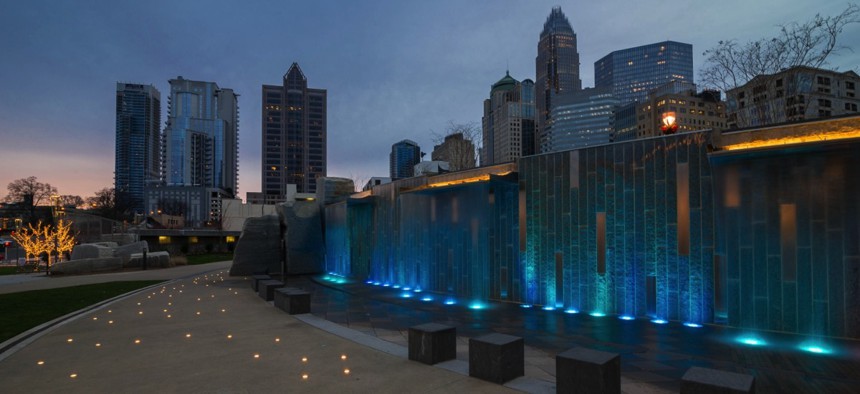Local Government Takes a Backseat in Charlotte’s Energy Initiative

Charlotte, North Carolina Serge Skiba / Shutterstock.com

Connecting state and local government leaders
Envision Charlotte has a bold plan for 20 percent energy savings in Uptown by 2016 and the nonprofit framework to make it happen.
When stakeholders in Charlotte, North Carolina, decided to reduce energy use in the Uptown central business district by 20 percent in just five years by 2016, they opted against a traditional governmental approach and framework.
The nonprofit group shouldering the task, Envision Charlotte, includes city and county government, university, utility and corporate representatives on its board of directors.
Executive Director Amy Aussieker, in an interview, called it a “public-private-plus partnership” and while it might surprise outsiders unfamiliar with the history of collaborative, community-focused sustainability efforts in the nation’s second-largest financial center, it’s a model she said that others can learn from.
“I think one of the great benefits is that Envision is not a government entity. It is a 501(c)(4), where government is at the table,” Rob Phocas, the city of Charlotte’s energy and sustainability manager, said in an interview.
“Not only do you avoid the stigma of it being another government project, but it just provides more flexibility in terms of procurement—getting you out of an area that can slow things down.”
In fall 2010, Charlotte Center City Partners, Duke Energy CEO Jim Rogers and Intelligent Buildings announced the 20 percent energy-reduction goal, and by 2011 “shadow” meters were being installed in most of Uptown’s buildings of 10,000 square feet or more.
The meters, paid for by Duke Energy, collect energy data that’s used to brainstorm new ways to find efficiencies and track savings. An impressive 61 out of 64 Uptown buildings that had been targeted agreed to have the meters installed, including the Bank of America headquarters and Wells Fargo eastern headquarters.
Envision’s efforts make it cheaper to do business and thus easier to attract tenants, Aussieker said.
“For us it’s been a great economic development tool, and Charlotte is a business city,” she said. “To show we’ve saved Uptown businesses $10 million is huge.”
That number was determined last summer when Duke Energy confirmed 8.4 percent energy savings had been achieved—6.2 percent from behavioral changes.
To improve upon that, Duke Energy’s Smart Energy in Offices program encourages tenants to do little things like turn off office lights and unplug phone chargers not in use.
Engineering and architecture students at the University of North Carolina at Charlotte’s Center for Sustainability Integrated Buildings and Sites started holding energy roundtables, where they meet with property managers and engineers and tell them the best ways to find more energy efficiencies.
New Envision energy savings numbers, showing improvement, are expected in the next few weeks, Aussieker said.
The first energy audits were critical to corporate leadership buying into the program at high levels with “the economic message carrying the day more than the environmental,” Phocas said.
Mecklenburg County Sustainability Officer Heidi Pruess and Phocas are their governments’ representatives on the Envision board, which meets almost daily, Aussieker said.
Phocas has been working to seek approval for water sensors to be added to utility poles and oversaw the incorporation of the Charlotte-Mecklenburg Government Building and City Hall into the sustainability initiative.
“Other cities should decide what mediums are important to them: just energy, energy and water or something completely different like green space and figure out key partners to get at the table,” Phocas said. “Collaboration is the key to success.”
Because Charlotte is trying to position itself as a smart city, City Hall is “in lockstep” with Envision on all its initiatives, Aussieker said.
Water and waste transmitters in 15 Enevo waste receptacles and haulers continue to be calibrated to set benchmarks that will help gauge program effectiveness when data collection starts in about two weeks.
“What’s interesting is new Uptown buildings are calling us, even though they’re outside our footprint, wanting to be an Envision building,” she said. “Twenty percent [energy savings] in California is a lot more than 20 percent here, so there’s a compelling argument for cities to continue to get involved in an initiative like this.”

NEXT STORY: What to look for in rugged tech





